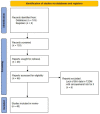Bioelectrical Impedance Analysis for the Assessment of Body Composition in Sarcopenia and Type 2 Diabetes
- PMID: 35565832
- PMCID: PMC9099885
- DOI: 10.3390/nu14091864
Bioelectrical Impedance Analysis for the Assessment of Body Composition in Sarcopenia and Type 2 Diabetes
Abstract
Sarcopenia is emerging as a severe complication in type 2 diabetes (T2DM). On the other hand, it has been documented that nutritional aspects, such as insufficient protein or total energy intake, increase sarcopenia risk. The analysis of body composition is a relevant approach to assess nutritional status, and different techniques are available. Among such techniques, bioelectrical impedance analysis (BIA) is particularly interesting, since it is non-invasive, simple, and less expensive than the other techniques. Therefore, we conducted a review study to analyze the studies using BIA for body composition analysis in T2DM patients with sarcopenia or at risk of catching it. Revised studies have provided important information concerning relationships between body composition parameters (mainly muscle mass) and other aspects of T2DM patients' conditions, including different comorbidities, and information on how to avoid muscle mass deterioration. Such relevant findings suggest that BIA can be considered appropriate for body composition analysis in T2DM complicated by sarcopenia/muscle loss. The wide size of the patients' cohort in many studies confirms that BIA is convenient for clinical applications. However, studies with a specific focus on the validation of BIA, in the peculiar population of patients with T2DM complicated by sarcopenia, should be considered.
Keywords: appendicular muscle mass; bioelectrical impedance analysis; body composition; sarcopenia; skeletal muscle mass; type 2 diabetes.
Conflict of interest statement
The authors declare no conflict of interest.
Figures



Similar articles
-
Developing and Validating an Age-Independent Equation Using Multi-Frequency Bioelectrical Impedance Analysis for Estimation of Appendicular Skeletal Muscle Mass and Establishing a Cutoff for Sarcopenia.Int J Environ Res Public Health. 2017 Jul 19;14(7):809. doi: 10.3390/ijerph14070809. Int J Environ Res Public Health. 2017. PMID: 28753945 Free PMC article.
-
Validation of a multi-frequency bioelectrical impedance analysis device for the assessment of body composition in older adults with type 2 diabetes.Nutr Diabetes. 2022 Oct 20;12(1):45. doi: 10.1038/s41387-022-00223-1. Nutr Diabetes. 2022. PMID: 36266263 Free PMC article.
-
Estimation of prevalence of sarcopenia by using a new bioelectrical impedance analysis in Chinese community-dwelling elderly people.BMC Geriatr. 2016 Dec 28;16(1):216. doi: 10.1186/s12877-016-0386-z. BMC Geriatr. 2016. PMID: 28031025 Free PMC article.
-
Bioelectrical impedance analysis in the assessment of sarcopenia.Curr Opin Clin Nutr Metab Care. 2018 Sep;21(5):366-374. doi: 10.1097/MCO.0000000000000496. Curr Opin Clin Nutr Metab Care. 2018. PMID: 29957677 Review.
-
Bioelectrical Impedance Analysis for the Assessment of Sarcopenia in Patients with Cancer: A Systematic Review.Oncologist. 2020 Feb;25(2):170-182. doi: 10.1634/theoncologist.2019-0600. Epub 2019 Nov 12. Oncologist. 2020. PMID: 32043785 Free PMC article.
Cited by
-
Comparisons of Two Bioelectrical Impedance Devices and Manual versus Sensor-Based Short Physical Performance Batteries for Assessment of Muscle Mass and Physical Performance.Sensors (Basel). 2023 Jun 29;23(13):6026. doi: 10.3390/s23136026. Sensors (Basel). 2023. PMID: 37447873 Free PMC article.
-
Circulating short chain fatty acid levels and body composition in type 2 diabetes mellitus.Int J Med Sci. 2025 Apr 22;22(10):2289-2297. doi: 10.7150/ijms.111920. eCollection 2025. Int J Med Sci. 2025. PMID: 40386047 Free PMC article.
-
Intradialytic Exercise: Effects on Arterial Stiffness and Gait Speed in Patients Undergoing Hemodialysis.Med Sci Monit. 2025 Apr 19;31:e947604. doi: 10.12659/MSM.947604. Med Sci Monit. 2025. PMID: 40251803 Free PMC article. Clinical Trial.
-
Combined Aerobic Exercise with Intermittent Fasting Is Effective for Reducing mTOR and Bcl-2 Levels in Obese Females.Sports (Basel). 2024 Apr 25;12(5):116. doi: 10.3390/sports12050116. Sports (Basel). 2024. PMID: 38786985 Free PMC article.
-
Role of Muscle Ultrasound for the Study of Frailty in Elderly Patients with Diabetes: A Pilot Study.Biology (Basel). 2023 Jun 19;12(6):884. doi: 10.3390/biology12060884. Biology (Basel). 2023. PMID: 37372168 Free PMC article.
References
-
- Takahashi F., Hashimoto Y., Kaji A., Sakai R., Okamura T., Kitagawa N., Okada H., Nakanishi N., Majima S., Senmaru T., et al. Sarcopenia Is Associated with a Risk of Mortality in People with Type 2 Diabetes Mellitus. Front. Endocrinol. 2021;12:783363. doi: 10.3389/fendo.2021.783363. - DOI - PMC - PubMed
Publication types
MeSH terms
LinkOut - more resources
Full Text Sources
Medical

